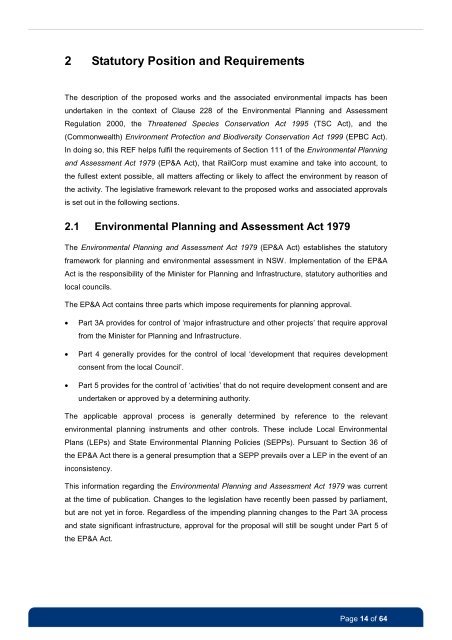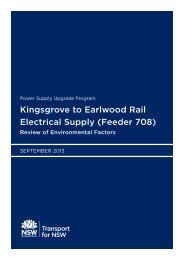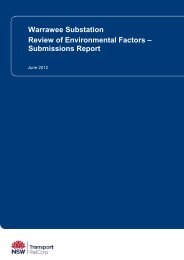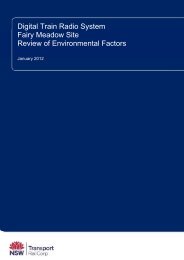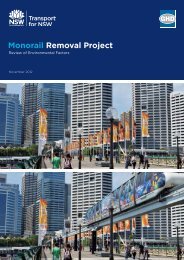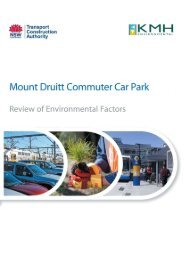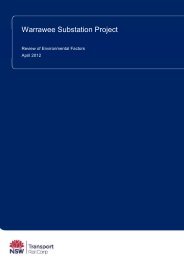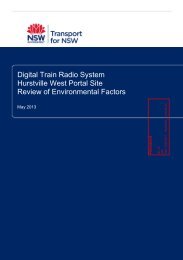Review of Environmental Factors - Transport for NSW - NSW ...
Review of Environmental Factors - Transport for NSW - NSW ...
Review of Environmental Factors - Transport for NSW - NSW ...
You also want an ePaper? Increase the reach of your titles
YUMPU automatically turns print PDFs into web optimized ePapers that Google loves.
2 Statutory Position and RequirementsThe description <strong>of</strong> the proposed works and the associated environmental impacts has beenundertaken in the context <strong>of</strong> Clause 228 <strong>of</strong> the <strong>Environmental</strong> Planning and AssessmentRegulation 2000, the Threatened Species Conservation Act 1995 (TSC Act), and the(Commonwealth) Environment Protection and Biodiversity Conservation Act 1999 (EPBC Act).In doing so, this REF helps fulfil the requirements <strong>of</strong> Section 111 <strong>of</strong> the <strong>Environmental</strong> Planningand Assessment Act 1979 (EP&A Act), that RailCorp must examine and take into account, tothe fullest extent possible, all matters affecting or likely to affect the environment by reason <strong>of</strong>the activity. The legislative framework relevant to the proposed works and associated approvalsis set out in the following sections.2.1 <strong>Environmental</strong> Planning and Assessment Act 1979The <strong>Environmental</strong> Planning and Assessment Act 1979 (EP&A Act) establishes the statutoryframework <strong>for</strong> planning and environmental assessment in <strong>NSW</strong>. Implementation <strong>of</strong> the EP&AAct is the responsibility <strong>of</strong> the Minister <strong>for</strong> Planning and Infrastructure, statutory authorities andlocal councils.The EP&A Act contains three parts which impose requirements <strong>for</strong> planning approval.• Part 3A provides <strong>for</strong> control <strong>of</strong> ‘major infrastructure and other projects’ that require approvalfrom the Minister <strong>for</strong> Planning and Infrastructure.• Part 4 generally provides <strong>for</strong> the control <strong>of</strong> local ‘development that requires developmentconsent from the local Council’.• Part 5 provides <strong>for</strong> the control <strong>of</strong> ‘activities’ that do not require development consent and areundertaken or approved by a determining authority.The applicable approval process is generally determined by reference to the relevantenvironmental planning instruments and other controls. These include Local <strong>Environmental</strong>Plans (LEPs) and State <strong>Environmental</strong> Planning Policies (SEPPs). Pursuant to Section 36 <strong>of</strong>the EP&A Act there is a general presumption that a SEPP prevails over a LEP in the event <strong>of</strong> aninconsistency.This in<strong>for</strong>mation regarding the <strong>Environmental</strong> Planning and Assessment Act 1979 was currentat the time <strong>of</strong> publication. Changes to the legislation have recently been passed by parliament,but are not yet in <strong>for</strong>ce. Regardless <strong>of</strong> the impending planning changes to the Part 3A processand state significant infrastructure, approval <strong>for</strong> the proposal will still be sought under Part 5 <strong>of</strong>the EP&A Act.Page 14 <strong>of</strong> 64


